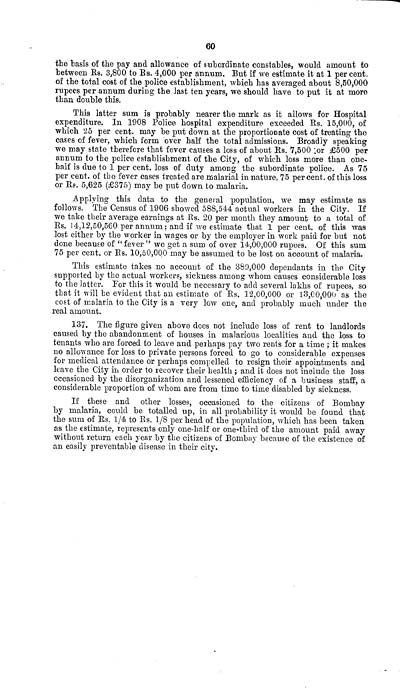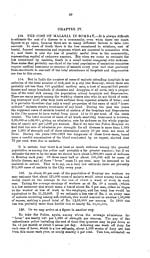Medicine - Disease > Report of an investigation into the causes of malaria in Bombay and the measures necessary for its control
(91) Page 60
Download files
Individual page:
Thumbnail gallery: Grid view | List view

60
the basis of the pay and allowance of subordinate constables, would amount to
between Rs. 3,800 to Rs. 4,000 per annum. But if we estimate it at 1 per cent. of the total cost of the police establishment, which has averaged about 8,50,000
rupees per annum during the last ten years, we should have to put it at more
than double this.
This latter sum is probably nearer the mark as it allows for Hospital
expenditure. In 1908 Police hospital expenditure exceeded Rs. 15,000, of
which 25 per cent. may be put down at the proportionate cost of treating the
cases of fever, which form over half the total admissions. Broadly speaking
we may state therefore that fever causes a loss of about Rs. 7,500 or 500 per
annum to the police establishment of the City, of which loss more than one-
half is due to 1 per cent. loss of duty among the subordinate police. As 75
per cent. of the fever cases treated are malarial in nature, 75 per cent. of this loss
or Rs. 5,625 (375) may be put down to malaria.
Applying this data to the general population, we may estimate as
follows. The Census of 1906 showed 588,544 actual workers in the City. If
we take their average earnings at Rs. 20 per month they amount to a total of
Rs. 14,12,50,560 per annum; and if we estimate that 1 per cent. of this was
lost either by the worker in wages or by the employer in work paid for but not
done because of "fever" we get a sum of over 14,00,000 rupees. Of this sum
75 per cent. or Rs. 10,50,000 may be assumed to be lost on account of malaria.
This estimate takes no account of the 389,000 dependants in the City
supported by the actual workers, sickness among whom causes considerable loss
to the latter. For this it would be necessary to add several lakhs of rupees, so
that it will be evident that an estimate of Rs. 12,00,000 or 13,00,000 as the
cost of malaria to the City is a very low one, and probably much under the
real amount.
137. The figure given above does not include loss of rent to landlords
caused by the abandonment of houses in malarious localities and the loss to
tenants who are forced to leave and perhaps pay two rents for a time; it makes
no allowance for loss to private persons forced to go to considerable expenses
for medical attendance or perhaps compelled to resign their appointments and
leave the City in order to recover their health; and it does not include the loss
occasioned by the disorganization and lessened efficiency of a business staff, a
considerable proportion of whom are from time to time disabled by sickness.
If these and other losses, occasioned to the citizens of Bombay
by malaria, could be totalled up, in all probability it would be found that
the sum of Rs. 1/4 to Rs. 1/8 per head of the population, which has been taken
as the estimate, represents only one-half or one-third of the amount paid away
without return each year by the citizens of Bombay because of the existence of
an easily preventable disease in their city.
the basis of the pay and allowance of subordinate constables, would amount to
between Rs. 3,800 to Rs. 4,000 per annum. But if we estimate it at 1 per cent. of the total cost of the police establishment, which has averaged about 8,50,000
rupees per annum during the last ten years, we should have to put it at more
than double this.
This latter sum is probably nearer the mark as it allows for Hospital
expenditure. In 1908 Police hospital expenditure exceeded Rs. 15,000, of
which 25 per cent. may be put down at the proportionate cost of treating the
cases of fever, which form over half the total admissions. Broadly speaking
we may state therefore that fever causes a loss of about Rs. 7,500 or 500 per
annum to the police establishment of the City, of which loss more than one-
half is due to 1 per cent. loss of duty among the subordinate police. As 75
per cent. of the fever cases treated are malarial in nature, 75 per cent. of this loss
or Rs. 5,625 (375) may be put down to malaria.
Applying this data to the general population, we may estimate as
follows. The Census of 1906 showed 588,544 actual workers in the City. If
we take their average earnings at Rs. 20 per month they amount to a total of
Rs. 14,12,50,560 per annum; and if we estimate that 1 per cent. of this was
lost either by the worker in wages or by the employer in work paid for but not
done because of "fever" we get a sum of over 14,00,000 rupees. Of this sum
75 per cent. or Rs. 10,50,000 may be assumed to be lost on account of malaria.
This estimate takes no account of the 389,000 dependants in the City
supported by the actual workers, sickness among whom causes considerable loss
to the latter. For this it would be necessary to add several lakhs of rupees, so
that it will be evident that an estimate of Rs. 12,00,000 or 13,00,000 as the
cost of malaria to the City is a very low one, and probably much under the
real amount.
137. The figure given above does not include loss of rent to landlords
caused by the abandonment of houses in malarious localities and the loss to
tenants who are forced to leave and perhaps pay two rents for a time; it makes
no allowance for loss to private persons forced to go to considerable expenses
for medical attendance or perhaps compelled to resign their appointments and
leave the City in order to recover their health; and it does not include the loss
occasioned by the disorganization and lessened efficiency of a business staff, a
considerable proportion of whom are from time to time disabled by sickness.
If these and other losses, occasioned to the citizens of Bombay
by malaria, could be totalled up, in all probability it would be found that
the sum of Rs. 1/4 to Rs. 1/8 per head of the population, which has been taken
as the estimate, represents only one-half or one-third of the amount paid away
without return each year by the citizens of Bombay because of the existence of
an easily preventable disease in their city.
Set display mode to: Large image | Zoom image | Transcription
Images and transcriptions on this page, including medium image downloads, may be used under the Creative Commons Attribution 4.0 International Licence unless otherwise stated. ![]()
| India Papers > Medicine - Disease > Report of an investigation into the causes of malaria in Bombay and the measures necessary for its control > (91) Page 60 |
|---|
| Permanent URL | https://digital.nls.uk/74573178 |
|---|




